The cost of roofing materials in Kenya is a key factor in any building project. This guide covers popular roofing materials, prices per square meter, gutter options, and common myths to avoid.
Pitched Roofing Materials In Kenya.
1.Corrugated Roofing Sheets:
| Types of Iron Sheets | Estimated Costs Per Running Meter | Gauge | Description |
| Corrugated | 490-700 | 28-30 | Traditional wavy design, widely used in rural homes and simple structures. |
| Box Profile Mabati | 500-600 | 30 | Modern flat-ribbed design for a sleek, urban look. |
| Galvanized | 500-700 | 30 | Zinc-coated for basic rust resistance; traditional but prone to corrosion over time. |
| Aluzinc Sheets | 600-750 | 28-30 | Aluminum-Zinc coated for superior rust protection, shiny spangled finish, longer lasting than regular galvanized sheets. |
| Pre-painted (Color Coated) | 550-800 | 28-30 | Color coated for aesthetics and extra weather protection; often has Aluzinc base. |
| Stone-coated | 750-850 | 28 | Premium finish, mimics tiles, reduces noise, and provides exceptional durability. |
Advantages:
- Readily available
- Easy to install
- Affordable
Disadvantages:
- Noisy during rain
- Tends to rust if not coated properly
- Fades over time
- Collects dust easily
Gauge matters:
- Common gauges: 30G (light), 28G (medium), 26G (heavy-duty)
- Thicker = more expensive but longer-lasting
- 28G box profile is a good balance for most residential homes
Best for rainwater collection: Pre-painted or stone-coated types
For tight budgets: Galvanized corrugated sheets (may need early replacement)
Urban homes: Box profile is clean and modern
Recommended Gutters: PVC, Aluminum, or Color-Coated
Leading manufacturers like Mabati Rolling Mills (MRM) offer a wide range of corrugated, box profile, and aluzinc sheets, including popular brands like Dumuzas (their patented Aluzinc) and DumuRangi (their pre-painted Aluzinc).”
2. Stone-Coated Steel Tiles (Decra-like)
All Decra roofs are stone-coated, but not all stone-coated roofs are Decra.
Decra is a brand name from New Zealand, many people use the word loosely, but only products sold by Decra-licensed distributors are truly Decra.
Here’s the difference,
| Description | Origin | Quality | Warranty | Cost per m² | Availability |
| Decra (Brand) | New-Zealand | Globally Certified | 40-50years | 2,800–3,500 | Licensed Distributors Only |
| Stone Coated Tiles (General) | Made by Various Companies | Quality Varies with imitations | Not Standardized | 1,800–2,800 | Widely Available |
Advantages:
- Highly durable
- Long warranty (Decra)
- Excellent for water harvesting (less contamination)
- Very durable (rust and fade resistant)
- Requires less reinforcement compared to clay or concrete tiles
- Quieter during rain than mabati
Disadvantages:
- Expensive
- Poor Installation can lead to Leakages
- Prone to fake imitations
- Repairs need skilled handling
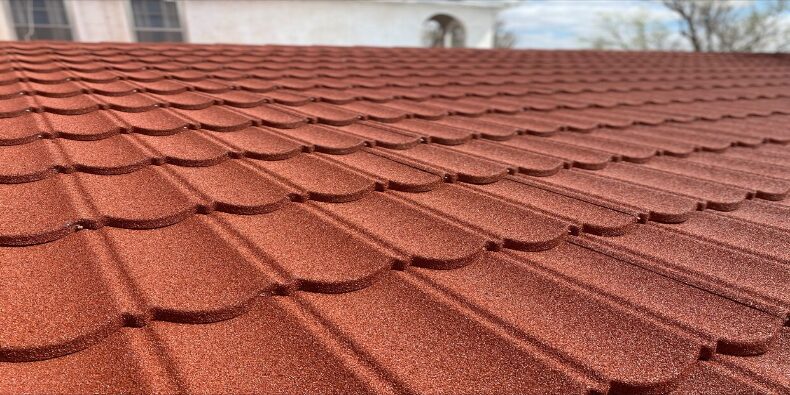
3.Clay Tiles
Made from natural clay, common in Kisii, Meru, and Nairobi.
- Cost in Kenya: Ksh 1,500–2,500 per sqm
- Color: Natural terracotta or red-brown
Key Features:
- Lifespan: 30–60 years
- Baked natural clay
- Heavy, needs strong trusses
- Water Resistance: apply a waterproof sealant on the surface especially in rainy or humid areas
- Fireproof
Advantages:
- Good thermal insulation
- Long lifespan
- Visually appealing
- Clay tiles are generally very quiet.
Disadvantages:
- Heavy to install and transport
- Can break during transport/installation
- Algae growth and dust accumulation if not cleaned
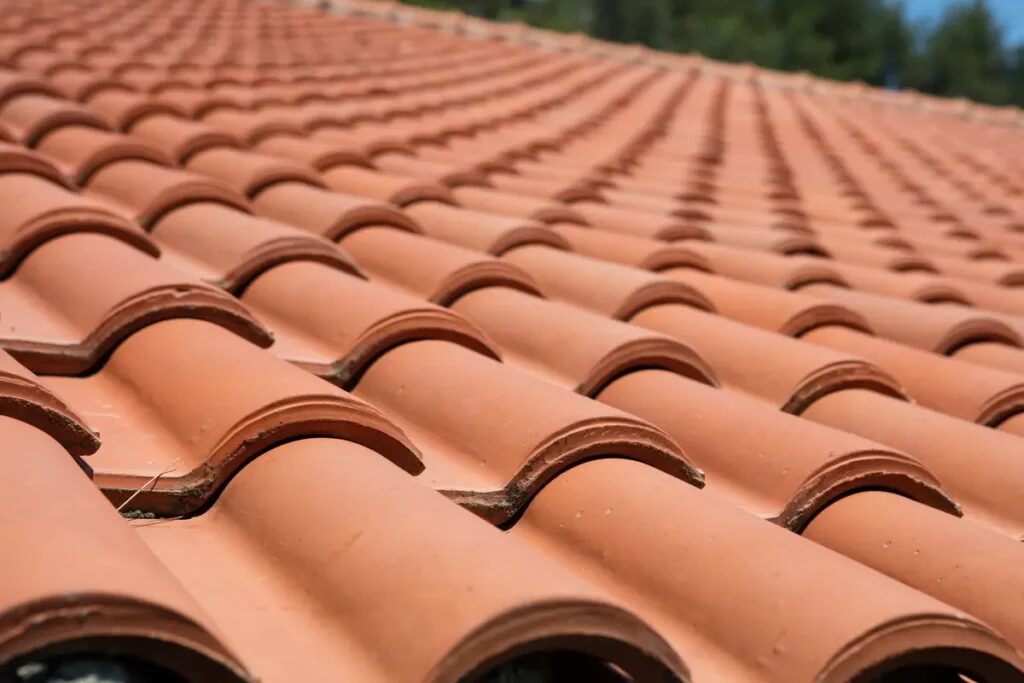
4. Metal Shingles
These mimic tiles or slate but are made from steel, aluminum, or copper, similar in appearance to stone-coated Decra tiles.
Cost in Kenya:
- Ksh 650–750 per tile
- Ksh 2,800 – 4,500 per sqm (materials + labor)
Advantages:
- Extremely durable (40–70 years lifespan)
- Lightweight, reducing load on trusses
- Low maintenance
- Energy-efficient with reflective coatings
- Excellent for rainwater harvesting (non-toxic)
- Resistant to Fire
Disadvantages:
- Expensive (imported; limited local options)
- Needs skilled installation
- Can be noisy without insulation
- May dent from falling branches
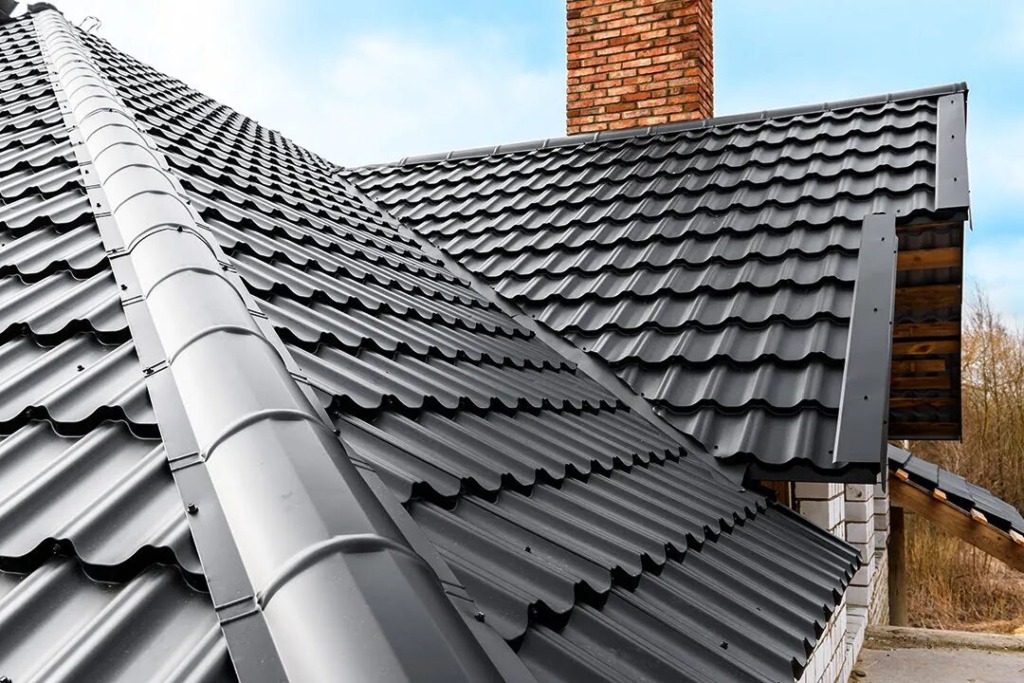
5.Natural Slate Roofing | Synthetic Slate
Slate is a natural stone, split into thin sheets from slate rock quarries. It’s used in roofing for its beauty and extreme longevity.
Synthetic Slate is however made from composite materials , usually a mix of plastic, rubber, or fiberglass.
Here’s a clear breakdown of the differences between natural slate and synthetic slate roofing:
| Description | Natural Slate | Synthetic Slate |
| Material | Thin, natural stone | Composite (plastic/rubber) |
| Life span | 75–100+ years | 40–50 years |
| Color | Natural in appearance with variations in color | Designed to mimic natural slate; more uniform in appearance |
| Weight | Extremely heavy. | Lightweight |
| Cost | Very Expensive KSh 6,000 – 10,000+ per m² | More affordable upfrontKSh 3,500 – 5,500 per m² |
| Installation | Requires Skilled labor | Easier and quicker to install; less fragile |
| Maintenance | Low but repairs can be costly | Low with affordable repairs |
| Water Harvesting | Excellent for water harvesting | Excellent but may leach chemicals or degrade over time |
| Availability | Less common | Increasingly popular for modern builds |
| Quality | Fireproof, waterproof, rot-proof,does not fade | Some low-quality versions fade or warp |
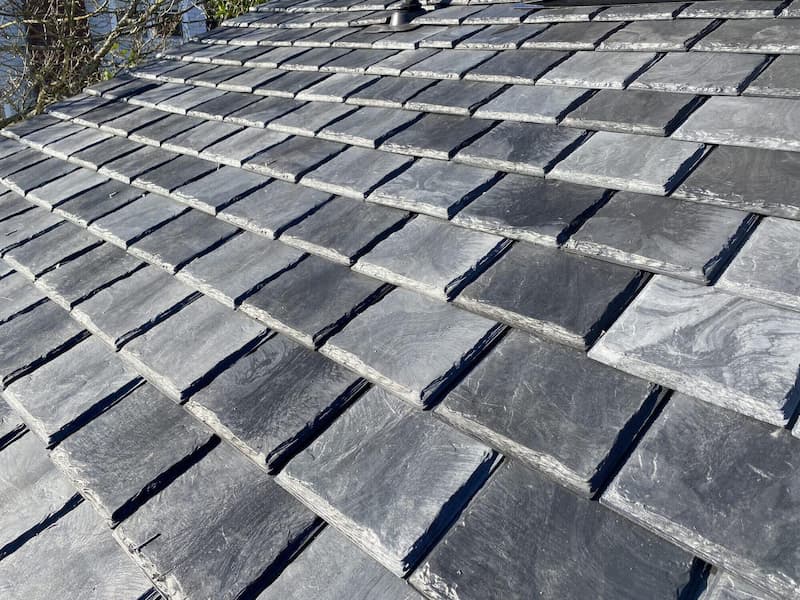
6.Asphalt Shingles Roofing.
Asphalt shingles are made from a base layer of either fiberglass or organic felt.
- Fiberglass is a lightweight, fire-resistant material made from fine glass fibers.
- Organic felt is made from recycled paper or wood fibers, pressed into a thick sheet and treated to resist water. It looks similar to cardboard.
- This base is then coated with asphalt, a waterproof substance, and topped with tiny ceramic granules that protect the roof from sun, rain, and add color.
Today, fiberglass shingles are more common than felt-based ones because they’re stronger, lighter, and more heat-resistant.
Architectural Shingles (also called Laminated or Dimensional Shingles) is the most common profile used in Kenya due to its better durability and visual appeal. They are usually imported from the US or South Africa, sold through specialty suppliers.
Cost in Kenya:
- Ksh 2,000 – 3,500 per square Meter
- Often requires import or special order
Advantages
- Affordable (in its market of origin)
- Easy to install
- Comes in many colors and patterns
- Moderate insulation value
- Best for highland climates (e.g., Limuru, Eldoret)
Disadvantages
- Shorter lifespan in tropical climates (15–25 years)
- Not suitable for hot, coastal, or arid zones
- Can warp or melt under intense heat (a concern in Kenyan lowlands)
- Not ideal for water harvesting due to bitumen leaching
- Not widely available locally

Best Material for Roofing Framing and Formwork in Kenya
In Kenya, the most commonly used materials for roof framing and formwork include:
Timber (Cypress, Eucalyptus, Bluegum)
- Affordable
- Easy to work with
- Readily available
- Treated timber resists rot and termites
For roofing battens, Cypress is more expensive but preferred over Bluegum due to its better resistance to warping and rot. Bluegum is cheaper but can warp over time.
For fascia boards, Eucalyptus (Bluegum) goes for Ksh 32–36 per foot (8″ × 1″).
If you’re on a budget and don’t mind doing extra treatment/painting, Bluegum is fine. But for long-term durability and aesthetics, Cypress is worth the extra cost for fascia boards.
Pine is more affordable (Ksh 17–42/ft), suitable where budget is tighter but less durable long-term.
Steel (Mild Steel or RHS – Rectangular Hollow Sections)
- Durable and long-lasting
- Fire resistant
- Low maintenance
Expect typical prices of Ksh 800–1,700 per meter depending on thickness and section size.
However, closed hollow sections tend to be a bit more expensive per kg than open sections due to welding and forming cost
For smaller structural framing, sizes like 60×40 or 80×40 mm with 2–3 mm thickness are widely used.
Best Roofs for Water Harvesting in Kenya
Best for Water Collection:
- Stone-coated tiles
- Pre-painted Mabati (non-lead based paint)
- Concrete tiles (if cleaned regularly)
Not Ideal for Water Harvesting:
- Asbestos (banned due to health risks)
- Old rusty iron sheets
- PVC roofs (can leach chemicals)
Roof Gutters in Kenya: Materials & Installation Costs
PVC Gutters
- Typical Gauge/Thickness:3–3.4 mm thick walls (5.2″/7″ size)
- Cost per Linear Meter: KSh 300 -350 per metre
- Basic accessories: from Ksh 150 to 600
- Lightweight plastic
- Easy to Install
- Affordable
- Rust Free
- Can warp or crack under extreme sun
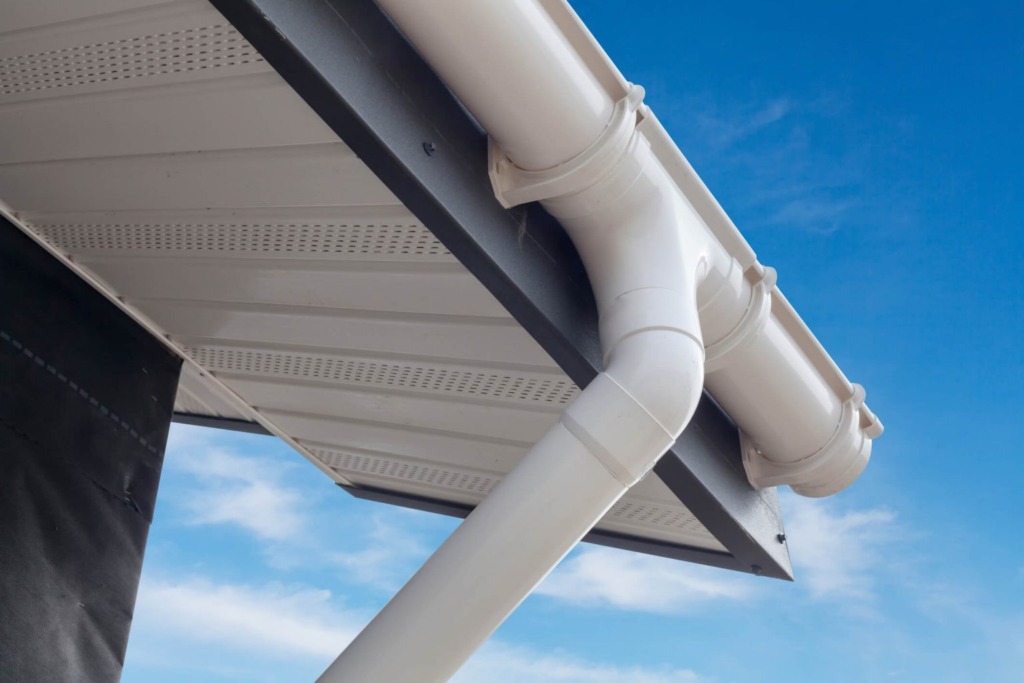
Aluminum Gutters
- Typical Gauge/Thickness:1.0 mm thick (7″ gutter)
- Cost per Linear Meter: Quote-based (estimate Ksh 600–800/m for popular 6″ K‑style)
- Lightweight
- Corrosion-resistant
- Works well in most Climate
- Can be painted
- It can form dents if not thick enough
- More expensive than PVC

Galvanized Steel Gutters
- Typical Gauge/Thickness: Similar to box‑profile (0.7–1.0 mm)
- Cost per Linear Meter: Ksh 600–1,350/m depending on size & strength
- Coated steel, strong and durable
- Best used in Wet Areas or Industrial buildings
- May rust if coating is damaged
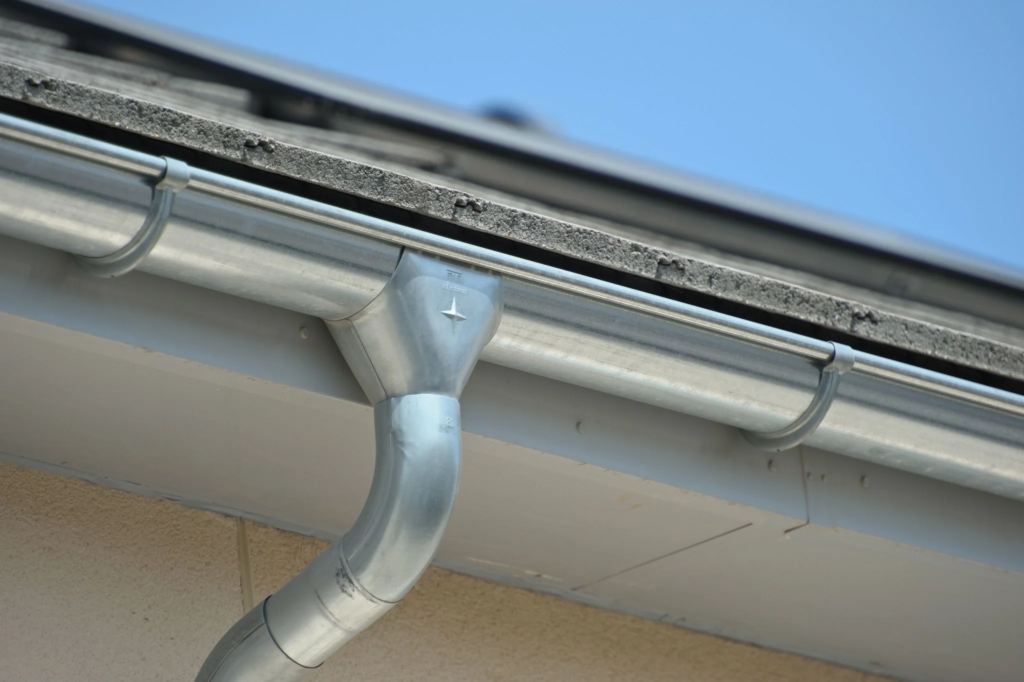
Concrete Gutters
- Typical Gauge/Thickness:Custom-built (50 mm+ wall)
- Cost per Linear Metre:(varies heavily)
- Common in commercial buildings
- Durable and long-lasting
- Customizable shape and size
- Doesn’t need painting or coating
- Requires expertise to install
- Expensive upfront cost compared to PVC or metal gutters.
- Difficult to repair
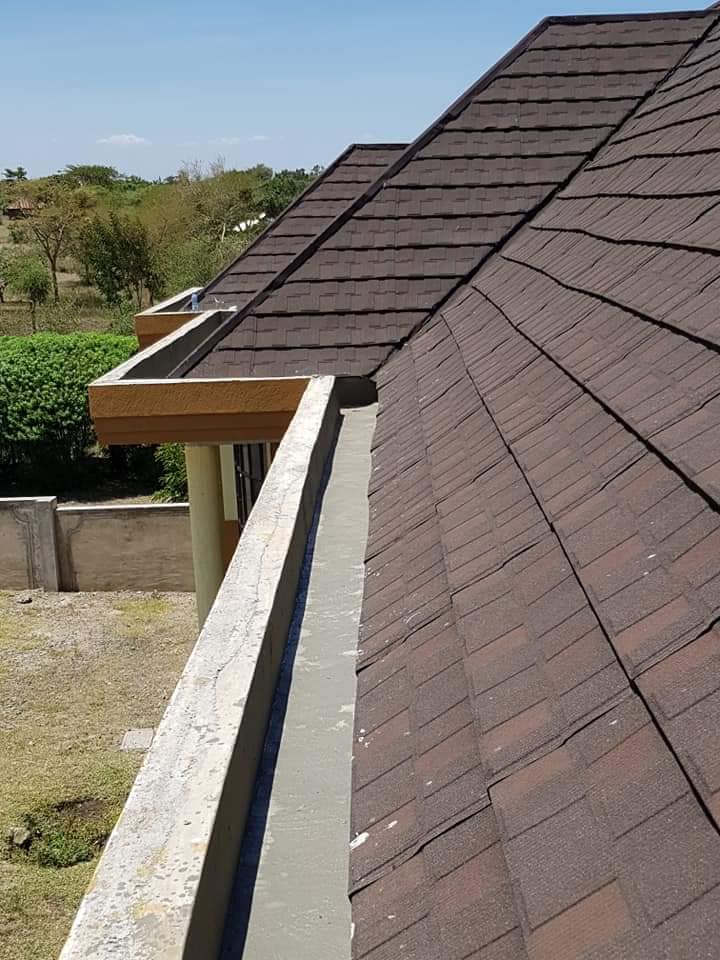
What to consider when choosing the right gutter
- Rainfall Intensity – use larger (7″) PVC or steel in wet regions.
- Roof Size & Pitch – steeper or bigger roofs need high-capacity gutters.
- Long-term & rust-free — choose aluminum or concrete.
- Budget-friendly & easy install — go PVC.
- Maintenance & Climate – use coated materials in coastal/high-humidity areas.
- Accessories & Installation – include hangers, corners, outlets: PVC fittings are Ksh 150–700 each
Step-by-Step Gutter Sizing & Cost Guide
1. Measure Your Roof Edge Length
You’ll need gutters along the eaves (the lowest horizontal edges of your roof).
- For a simple gable roof: Measure both long sides of the house.
- Example: If your house is 10m x 12m, and the roof slopes on the 12m sides:
Gutter length needed = 2 sides × 12m = 24 meters
| Step | Description | Example |
| 1.Measure the roof edge | Measure roof eave length (sides where water will drain) | Example: 12m roof slope × 2 sides = 24 meters of gutter needed |
| 2.Choose Gutter Type & Cost | Select based on your budget, climate, and roof type | Compare prices |
| 3.Calculate Gutter Cost | Multiply gutter length × price per metre | e.g. PVC: 24m × KSh 350 = KSh 8,400 |
| 4.Add Accessories | End caps (2 pcs) – Ksh 200 each Outlet (to downpipe) – Ksh 300–500 Downpipes – Ksh 400–600/m (you need 1 for every 8–12m of gutter) Gutter brackets/clips – Ksh 150–300 each (every 1m or 0.6m spacing) Elbows, joiners – Ksh 150–300 each | One for each gutter end Connect gutter to downpipe Usually 1 per 8–12 metres of gutter Install every 0.6m-1m Used for corners |
| 5.Estimate Accessory Cost | Use rough estimates per item | Brackets (24 × KSh 200 = KSh 4,800), end caps, downpipes, etc. = KSh 9,200 |
| 6.Add All Costs | Gutter cost + accessories = Total cost | 8,400 +9,200=17,600 |
Note: Prices vary slightly by seller, region, and quality.
Common Myths & Misconceptions about Roofing in Kenya
Myth 1: The heavier the roofing material, the better it is.
Truth: Heavier materials like concrete or clay tiles require strong trusses and can crack in poor installations. Weight doesn’t always mean durability.
Myth 2:Mabati is cheap and low quality
Truth: Today’s box profile, gauge 28+, or aluzinc-coated mabati can be strong, stylish, and long-lasting.
Myth 3: Roofing tiles don’t need gutters because water runs off clean.
Truth:Every roof should have gutters to protect the foundation and collect clean rainwater.
Myth 4:You can harvest water from any roof.
Truth:Not all materials are safe. Roofs painted with lead-based or low-quality paints can contaminate water.Asphalt shingles or low-grade painted sheets can leach chemicals or rust into the water
Myth 5: Cheap mabati is just as good as expensive ones.
Truth: Thinner sheets rust faster and can leak. Invest in quality for long-term savings
Myth 6: All “tile profile” roofs are stone-coated.
Truth: Some are simply pre-painted mabati designed to look like tiles. Always verify the material.
Myth 7:The more expensive the roof, the better it is.
Truth:High price doesn’t always mean better performance.Focus on material specs, warranty, and installer experience.
Myth 8:All roofing materials fade the same way
Truth: The type of roofing material differs e.g.
- Cheap mabati fades quickly in harsh sun.
- Stone-coated tiles fade less, especially those with UV-resistant coatings.
- Clay tiles don’t fade but may collect dust or moss.
- Painted roofs vary widely depending on the quality of paint.
Myth 9:You don’t need an underlayment (felt/polythene) with metal roofs
Truth: Underlayment is essential to prevent condensation, leaks, and heat buildup.
Our Advice
Choosing the right roofing material means balancing the upfront cost of roofing materials in Kenya with durability and visual appeal.
Not sure what to pick? Consult a trusted roofing expert or contractor before making a decision.
Got questions or tips? Leave a comment below or share this guide with someone planning to build
